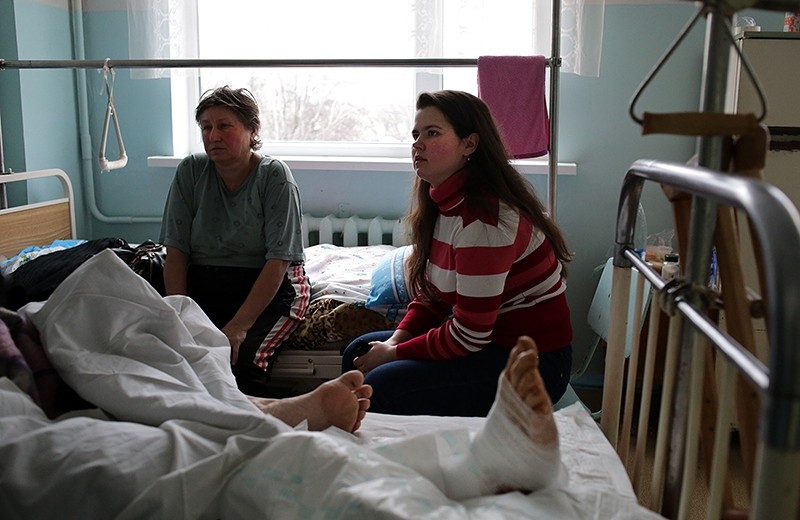MARIUPOL, Ukraine -- The death toll continued to climb in Mariupol on Jan. 25 after rockets fired from pro-Russian positions tore through a crowded suburb of the port city on Ukraine’s Black Sea shoreline.
Officials had listed the names of 30 people killed and 93 wounded by afternoon, but said that some of the remains had not been possible to identify. The final death toll could turn out to be even higher.
Thirty of the wounded were still fighting for their lives in various hospitals across the city, with the other 63 in non-critical condition. Five of the wounded were children, including two 3 year-olds, a 10 year-old, 11 year-old and 15 year-old. The youngest confirmed death in the attack was four year-old boy.
At Mariupol’s Hospital Number 4, the trauma wards were packed with victims of the attack. In the woman’s ward, few people were able to talk. A young woman wept as she tried to hide her face, disfigured by scars where separatist munitions had torn her skin. Another lay face down, a deep tear in the back of her neck.
Only one woman in the ward, Oksana Ivanova, a 31 year-old saleswoman, was sitting up and alert.
“I’d just got to work and was going through the doors when the shelling started – I fell,” she told the Kyiv Post.
“Afterwards I felt that everything hurts. I ran to a nearby shop, where the girl helped me get to an ambulance collecting the wounded. It was very scary and smoky, and I was in a daze. On the road there were so many wounded people. Doctors had to amputate the leg of a little girl, three years old, and both her parents were killed.”
On arriving in the hospital, she discovered glass and shrapnel had penetrated her left thigh and lower leg, and her torso was heavily bruised by the force of the impact.
Aleksandr Fedorovich, 58, was wheeled into the men’s ward having just returned from an operation to remove the rocket shrapnel, his bandaged ankle still bleeding. His wife and teenage granddaughter rushed to show him the medicine they had bought for him, knowing Ukraine’s impoverished healthcare system would be unlikely to provide it.
He had been in his garage working on his car when the rockets started to fall.
“I was terrified, I fell to the ground and turned my head away, before getting hit in the leg,” he said as he mixed a homemade saline solution in an old water bottle.
“Afterwards I went to the garage of my neighbors, I didn’t realize that I was wounded. Then I went outside and saw that I had a metal splinter in my leg. I pulled it out and took it with me. On the streets there were many, many people wounded. People bleeding, broken glass everywhere. Some people died on the way to hospital, some were already dead.”
His first thought was for his family in a nearby high-rise apartment block.
“I took the car and wanted to check if everything is fine with my granddaughter. I wanted to bring her to a bomb shelter. But my friend arrived and told me to go to the hospital, that they will take my granddaughter to shelter.”
Trudging through shattered glass, past burnt-out cars and buildings in the district devastated by rocket fire, it was difficult to comprehend the thinking behind such an indiscriminate attack.
A Ukrainian checkpoint is situated 500m from the impact zone, but those firing the Grad rockets would have known they were firing a notoriously inaccurate weapon at a densely populated area.
Five craters visited by the Kyiv Post indicated that the rockets had impacted from the east, in the direction of territory held by Kremlin-backed militants. Both rights organization Human Rights Watch and the OSCE have confirmed the rockets were fired from separatist held territory.
“(The OSCE) conducted a crater analysis and its initial assessment showed that the impacts were caused by Grad and Uragan rockets,” the organization said in a report published on its website.
“According to the impact analysis, the Grad rockets originated from a northeasterly direction, in the area of Oktyabr (19 kilometers northeast of Olimpiiska Street), and the Uragan rockets from an easterly direction, in the area of Zaichenko (15 kilometers east of Olimpiiska Street), both controlled by the Donetsk People’s Republic.”
Following the shelling of the city, Alexander Zakharchenko, a Kremlin-backed insurgent leader, said that separatists had launched an offensive in Mariupol.
“Today an offensive in Mariupol has begun,” Zakharchenko said at a ceremony commemorating civilians who were killed by shelling in Donetsk on Jan. 22, according to a video of the ceremony and reports by news agencies. “I hope we’ll surround the Debaltseve cauldron in a couple of days.”
Some commentators believe the attack was an attempt to distract Ukraine’s attention from the strategic railway town of Debaltseve, where Ukrainian troops are suffering heavy casualties as they fend off separatist attacks from three sides.
Kyiv Post editor Maxim Tucker can be reached at tucker@kyivpost.com or via twitter @MaxRTucker
Editor’s Note: This article has been produced with support from www.mymedia.org.ua, financially supported by the Ministry of Foreign Affairs of Denmark, and implemented by a joint venture between NIRAS and BBC Media Action. Content is independent of the financial donor.



